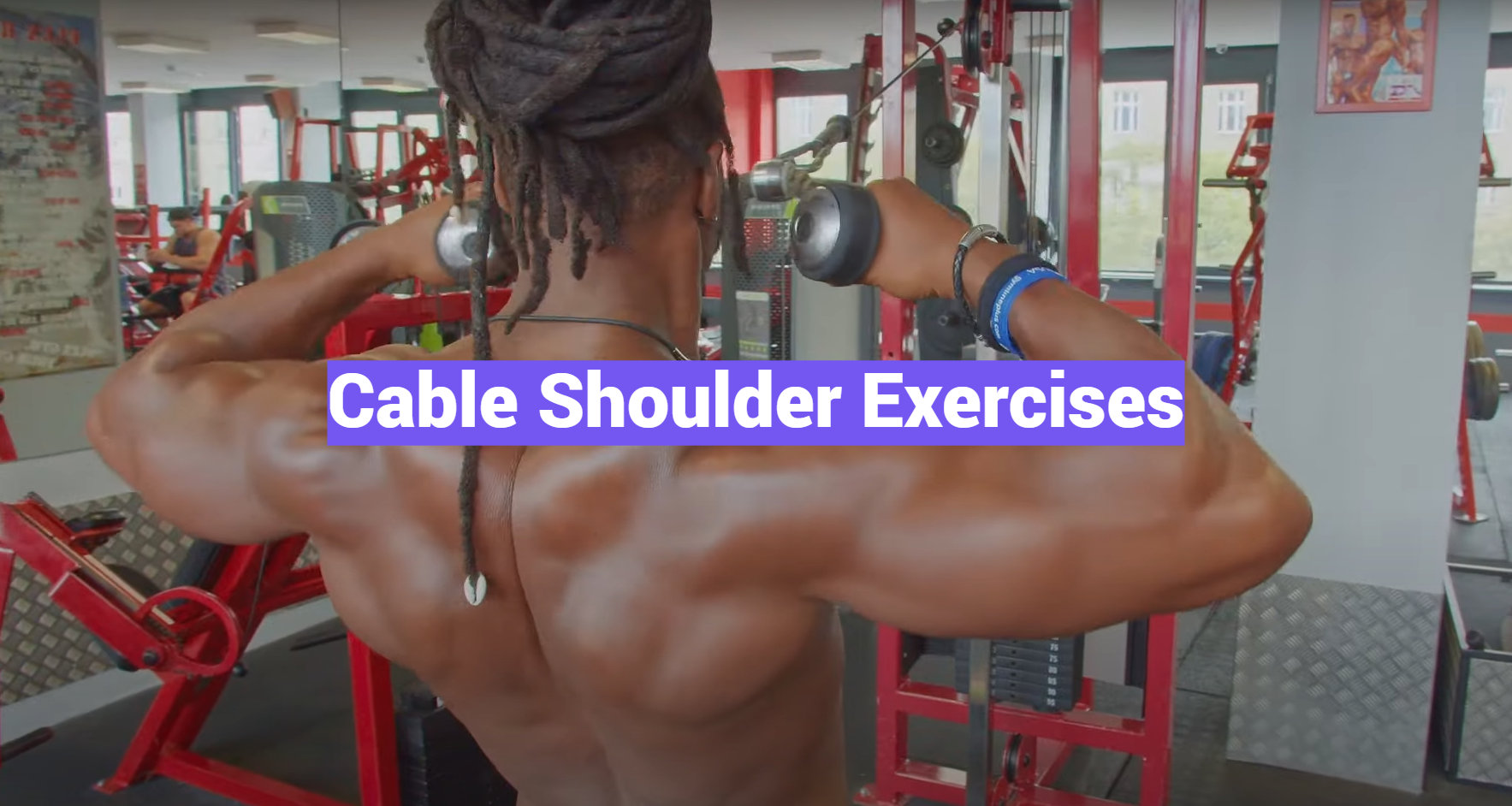Incorporating cable machines into your workout routine is an excellent way to target and strengthen your shoulder muscles. These versatile pieces of equipment offer consistent resistance throughout your entire range of motion, enhancing muscle activation and promoting balanced development. Whether you’re an experienced athlete or a fitness newbie, cable shoulder exercises can help you achieve your health goals and improve your overall upper body strength.
What are Cable Shoulder Exercises?
Cable shoulder exercises are a type of strength training exercise that target the muscles in your shoulders, specifically the deltoids. These exercises involve using a cable machine to provide resistance while performing various movements with your arms.
Most cable machines have adjustable cables that can be set at different heights and angles, allowing you to perform a wide range of shoulder exercises. This makes cable shoulder exercises versatile and suitable for people of all fitness levels.
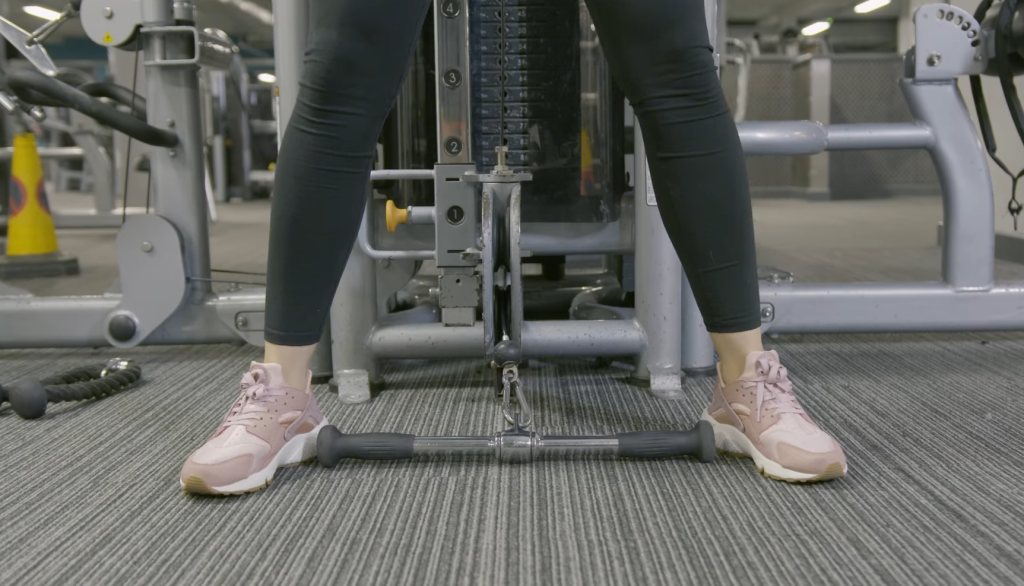
Benefits of Cable Shoulder Exercises
- Increased Muscle Activation:Due to the constant tension provided by the cable machine, your shoulder muscles are continuously engaged throughout the movement, resulting in better muscle activation and development.
- Improved Stability and Balance:As cable exercises require you to control the resistance, they help improve stability and balance in the shoulders, which can be beneficial for everyday activities and sports performance.
- Targeted Muscle Work:Cable shoulder exercises allow you to target specific areas of your shoulders by adjusting the cable height and angle, making them more effective than traditional free weight exercises.
- Lower Risk of Injury:The cable machine provides a smooth and controlled movement, reducing the risk of injury compared to using free weights, where momentum and improper form can lead to strains or sprains.
- Versatility:As mentioned earlier, cable machines offer a wide range of exercises for the shoulders, making them a versatile tool in your workout routine. You can target different areas of your shoulder muscles by adjusting the cable attachment and performing various movements. [1]
Examples of Cable Shoulder Exercises
- Cable Front Raise: Stand facing the cable machine, holding the handle with an overhand grip. With a slight bend in your elbow, raise your arm straight in front of you until it is parallel to the floor, then slowly lower it back down.
- Cable Lateral Raise: Stand side-on to the cable machine, holding onto the handle with an overhand grip. Keeping your arm straight, raise it out to the side until it is parallel to the floor, then lower it back down.
- Cable Shoulder Press:Stand facing away from the cable machine with the handle at shoulder height. Push the handle up and overhead until your arms are fully extended, then slowly lower them back down.
- Cable Reverse Fly: Stand facing the cable machine, holding onto the handle with an underhand grip. With a slight bend in your elbows, pull the handle back and out to your sides until your arms are parallel to the floor, then return to starting position.
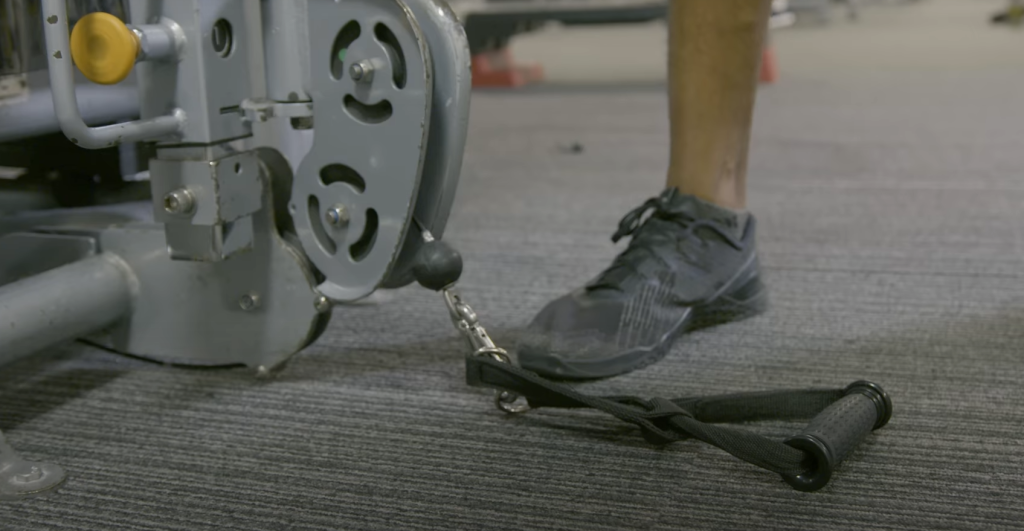
Incorporating Cable Shoulder Exercises into Your Workout Routine
To get the most out of cable shoulder exercises, it is best to incorporate them into a well-rounded workout routine that also includes other types of exercises, such as free weights and bodyweight movements.
Here are some tips for incorporating cable shoulder exercises into your workout:
- Start with a weight that challenges you but allows you to maintain proper form. Gradually increase the weight as you become stronger.
- Combine different cable shoulder exercises in one session to target all three heads of the deltoids and create a balanced workout.
- Perform 3-4 sets of each exercise, with 8-12 repetitions per set. Rest for 30-60 seconds between sets.
- Always warm up before starting any workout routine to prevent injury. [2]
How to Perform Cable Shoulder Exercises Safely
While cable shoulder exercises are generally safe, it is essential to perform them with proper form and technique to avoid injury. Here are some tips for performing cable shoulder exercises safely:
- Keep your core engaged throughout the movement to maintain stability and prevent strain on your back.
- Avoid using too much weight that causes you to lose control or compromise your form.
- Focus on a slow and controlled movement to prevent jerking or swinging.
- Consult a fitness professional if you are new to cable shoulder exercises or have any pre-existing shoulder injuries.
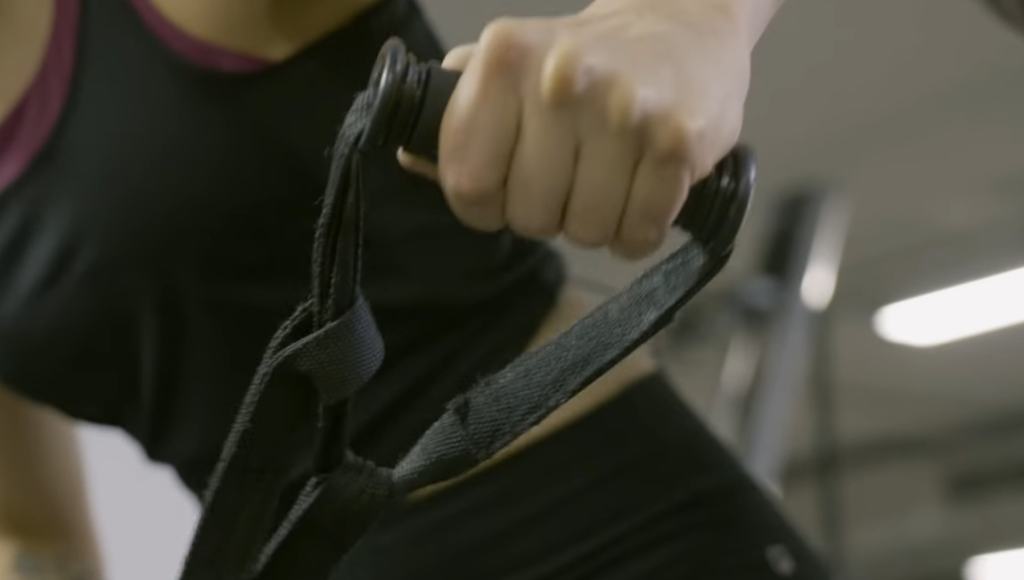
Precautions and Tips for Cable Shoulder Exercises
- If you experience any pain or discomfort during the exercise, stop immediately and consult a medical professional.
- Avoid locking your elbows at the top of the movement to prevent strain on the joints.
- Always start with lighter weight and gradually increase as you become stronger.
- Make sure your cable machine is in good condition, with no frayed cables or loose parts. [3]
Modifications and Variations for Cable Shoulder Exercises
For those with injuries or limited mobility, there are modifications and variations of cable shoulder exercises that can still target the deltoids effectively. Here are some examples:
- Seated Cable Shoulder Press:Sit on a bench facing away from the cable machine and perform a shoulder press as usual.
- Single Arm Cable Front Raise:Stand facing the cable machine, holding onto the handle with one hand. Raise your arm straight in front of you until it is parallel to the floor, then lower it back down.
- Cable Upright Row:Stand facing the cable machine, holding onto the handle with an overhand grip. Pull the handle up towards your chin, keeping your elbows out and close to your sides, then lower it back down.
Common Mistakes to Avoid While Performing Cable Shoulder Exercises
- Using too much weight:As mentioned before, using too much weight can lead to improper form and increase the risk of injury.
- Neglecting proper form:It is crucial to maintain proper form throughout the movement to target the intended muscles and prevent strain on other parts of your body.
- Not warming up properly:Skipping warm-up exercises can increase the risk of injury, especially when performing cable shoulder exercises that require stability and control.
- Relying solely on cable machines:While cable shoulder exercises are beneficial, it is important to incorporate other types of exercises into your routine for a well-rounded workout.
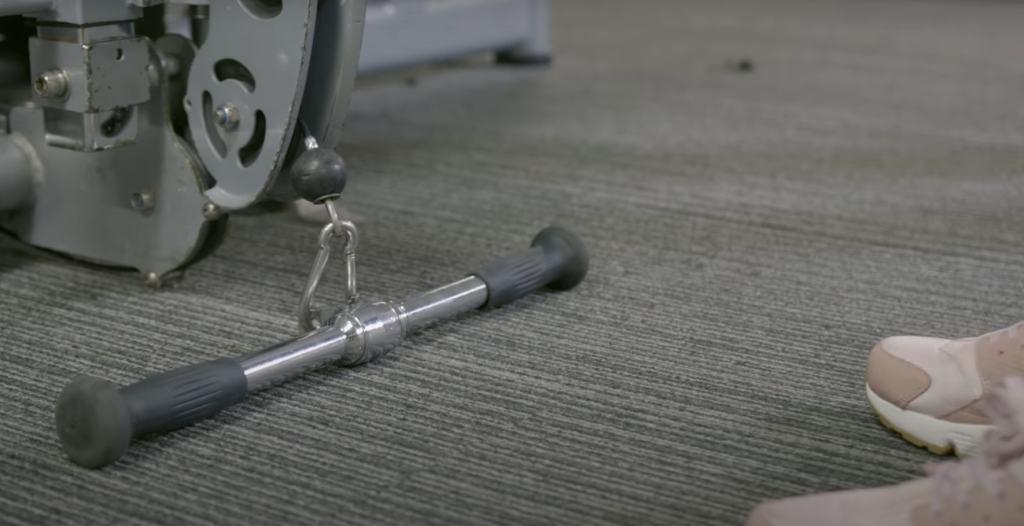
Sample Cable Shoulder Workout Plan
Here is a sample workout plan that incorporates cable shoulder exercises:
- Warm up with 5-10 minutes of light cardio and dynamic stretches.
- Perform 3 sets of each exercise, with 8-12 repetitions per set.
- Rest for 30 seconds between sets and 1 minute between exercises.
- Cable Front Raise – 3 sets, 10 reps
- Cable Lateral Raise – 3 sets, 10 reps
- Cable Shoulder Press – 3 sets, 10 reps
- Seated Cable Rear Delt Fly – 3 sets, 12 reps
- Single Arm Cable Front Raise – 3 sets, 12 reps (each side)
- Cable Upright Row – 3 sets, 12 reps
- Cool down with static stretches for the shoulders and upper body.
Remember to adjust the weight and number of repetitions based on your fitness level and goals. [4]
When to Incorporate Cable Shoulder Exercises into Your Routine
Cable shoulder exercises can be incorporated into your workout routine 2-3 times per week, depending on your fitness level and schedule. It is important to listen to your body and allow for adequate rest and recovery time between workouts.
In addition to dedicated shoulder workouts, cable shoulder exercises can also be added to full-body or upper body workouts.
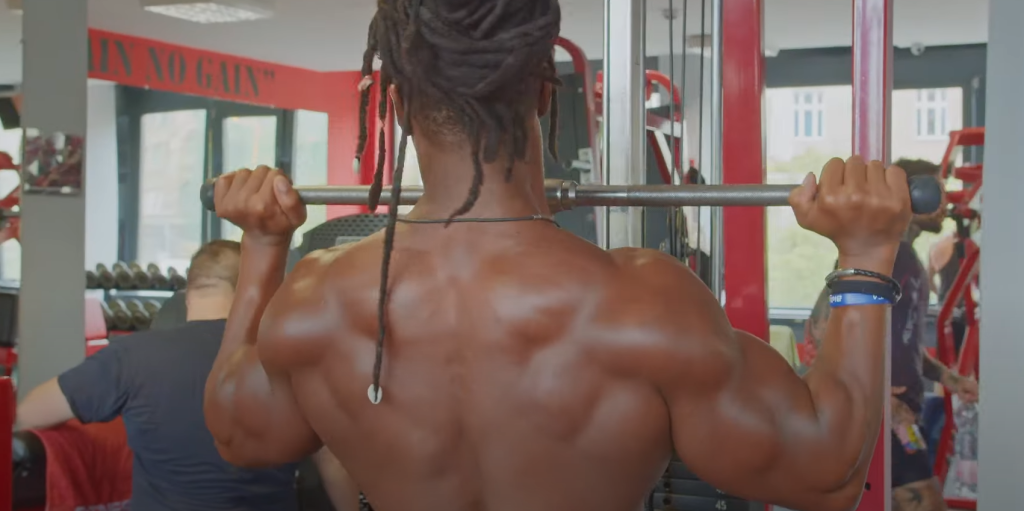
Top 15 Popular Cable Shoulder Exercises and How to Perform Them
- Cable Front Raise – Stand facing the cable machine with your arms at your sides, holding onto the handle with an overhand grip. Slowly raise both arms in front of you until they are parallel to the floor, then lower them back down.
- Cable Lateral Raise– Stand sideways to the cable machine with your arm closest to the machine holding onto the handle with an underhand grip. Slowly raise your arm out to the side until it is parallel to the floor, then lower it back down.
- Cable Shoulder Press– Stand facing away from the cable machine, holding onto the handles at shoulder height. Push both arms up overhead, then lower them back to starting position.
- Seated Cable Rear Delt Fly– Sit on a bench facing away from the cable machine, holding onto the handles with your arms straight out in front of you. Pull your arms back until they are parallel to the floor, then return to starting position.
- Single Arm Cable Front Raise– Stand facing the cable machine, holding onto the handle with one hand. Raise your arm straight in front of you until it is parallel to the floor, then lower it back down.
- Cable Upright Row– Stand facing the cable machine, holding onto the handle with an overhand grip. Pull the handle up towards your chin, keeping your elbows out and close to your sides, then lower it back down. [5]
- Cable Reverse Fly– Stand facing the cable machine with your arms extended in front of you, holding onto the handles with an overhand grip. Pull your arms out to the sides until they are parallel to the floor, then return to starting position.
- Cable High Row– Stand facing the cable machine with your arms extended straight down in front of you, holding onto the handles with an overhand grip. Pull your arms back until they are parallel to the floor, then return to starting position.
- Cable Face Pull– Stand facing the cable machine with a rope attachment on the highest setting. Grab onto the ropes and pull them towards your face, keeping your elbows out and close to your sides.
- Cable Shoulder Shrug– Stand sideways to the cable machine, holding onto the handle with one hand. Raise your shoulder towards your ear, then lower it back down.
- Single Arm Cable Lateral Raise– Stand facing the cable machine, holding onto the handle with one hand. Raise your arm out to the side until it is parallel to the floor, then lower it back down.
- Single Arm Cable Rear Delt Fly– Sit on a bench facing away from the cable machine, holding onto the handle with one hand. Pull your arm back until it is parallel to the floor, then return to starting position.
- Cable Y-Raise– Stand facing away from the cable machine, holding onto the handles at shoulder height. Raise both arms up and out to form a “Y” shape, then return to starting position.
- Cable T-Raise– Stand facing away from the cable machine, holding onto the handles at shoulder height. Raise both arms straight out to form a “T” shape, then return to starting position.
- Cable Shoulder Rotations– Stand sideways to the cable machine, holding onto the handle with one hand. Keeping your arm at shoulder height, rotate it in a circular motion as if drawing a circle on the wall. Repeat on both sides.
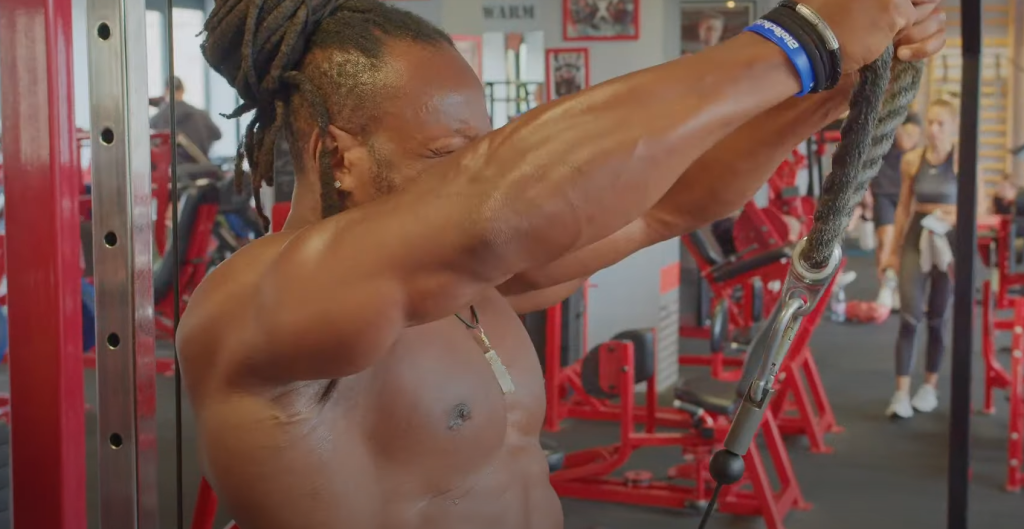
Nutrition Diet Tips for Strong and Healthy Shoulders
In addition to incorporating cable shoulder exercises into your workout routine, proper nutrition is essential for strong and healthy shoulders. Here are some tips to help nourish your muscles:
- Eat a balanced diet:Ensure that you are getting enough protein, carbohydrates, and healthy fats to support muscle growth and repair.
- Stay hydrated:Drink plenty of water to keep your muscles hydrated and functioning optimally.
- Include omega-3 fatty acids:These healthy fats can help reduce inflammation, which may improve shoulder joint health.
- Watch your sodium intake: Excess sodium consumption can lead to water retention and bloating, which can make the shoulders appear less defined. [6]
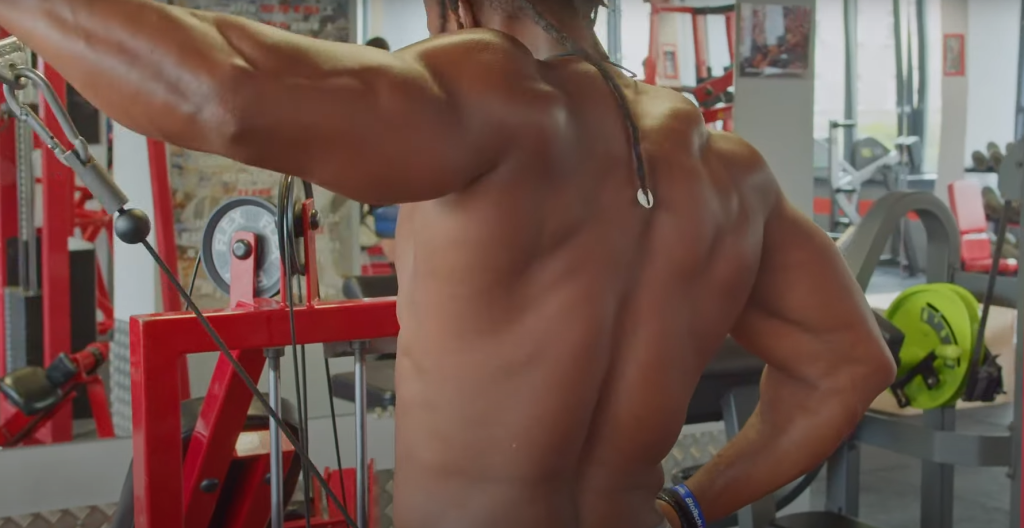
FAQs
What are some effective cable shoulder exercises?
Some popular cable shoulder exercises include front raises, lateral raises, shoulder presses, and rear delt flys.
How often should I do cable shoulder exercises?
Cable shoulder exercises can be incorporated into your workout routine 2-3 times per week. However, it is important to listen to your body and allow for adequate rest and recovery time between workouts.
Can I add cable shoulder exercises to my full-body workout?
Yes, cable shoulder exercises can be incorporated into full-body or upper body workouts. It is important to ensure proper form and technique to avoid injury.
Is nutrition important for strong and healthy shoulders?
Yes, proper nutrition is essential for supporting muscle growth and repair in the shoulders. A balanced diet that includes enough protein, healthy fats, and carbohydrates is important for nourishing the muscles. Additionally, staying hydrated and including omega-3 fatty acids in your diet can also benefit shoulder health.
What are the benefits of using a cable machine for shoulder exercises?
Using a cable machine for shoulder exercises can provide constant tension on the muscles, helping to improve strength and stability. It also allows for a wider range of motion compared to using dumbbells or resistance bands. Additionally, using a cable machine can help with targeting specific areas of the shoulders and creating an overall balanced physique.
How can I ensure I’m using the correct form when doing cable shoulder exercises?
It is important to start with lighter weights and focus on proper form and technique when using a cable machine for shoulder exercises. Engage your core, keep your shoulders back and down, and avoid using momentum to complete the movements. It can also be helpful to have a certified personal trainer demonstrate the exercises for you and provide feedback on your form. Remember to always listen to your body and make adjustments as needed to avoid injury. Lastly, be sure to warm up properly before starting your cable shoulder workout and cool down with some stretches afterwards to prevent soreness and aid in recovery. These tips will help ensure you are using the correct form and getting the most out of your cable shoulder exercises.
Can beginners start with cable shoulder exercises, or are they more suited for advanced individuals?
Cable shoulder exercises can be modified to suit all fitness levels. Beginners may start with lighter weights and focus on proper form, while more advanced individuals can increase the weight and intensity of their workouts. It is important for everyone to listen to their bodies and make adjustments as needed to avoid injury and continue progressing in their fitness journey. If you are unsure about where to start, it is always helpful to consult with a certified personal trainer for guidance and support.
Do cable shoulder exercises target all parts of the shoulder?
Yes, cable shoulder exercises can target all three heads of the deltoids: anterior (front), medial (side), and posterior (rear). Incorporating a variety of cable shoulder exercises into your routine can help achieve balanced shoulder development. Additionally, some exercises may also engage other muscles in the upper back and arms. Be sure to mix up your workouts and try different variations to target different areas of the shoulders.
Can cable shoulder exercises help prevent or alleviate shoulder pain?
Yes, incorporating cable shoulder exercises into your workout routine can help strengthen and stabilize the muscles in the shoulders, which may help prevent future injuries and alleviate existing shoulder pain. However, if you are experiencing chronic or severe shoulder pain, it is important to consult with a medical professional before starting any exercise program. They can help determine the underlying cause of your pain and provide appropriate treatment recommendations.
Are there any precautions to keep in mind when doing cable shoulder exercises?
As with any form of exercise, it is important to listen to your body and avoid pushing through sharp or intense pain. If you have a history of shoulder injuries, it may be beneficial to consult with a physical therapist or certified personal trainer for modifications and proper form to avoid aggravating any previous injuries. Additionally, always warm up properly before starting your workout and cool down with stretches afterwards to prevent injury and aid in recovery. Lastly, make sure the cable machine is set at an appropriate weight and height for your individual body and abilities.
What should I do if I feel pain while performing these exercises?
If you experience pain while performing cable shoulder exercises, stop the exercise immediately and assess your form and technique. If needed, lower the weight or modify the movement to avoid further discomfort. If you continue to experience pain, it is important to consult with a medical professional for proper diagnosis and treatment. Additionally, incorporating mobility and stretching exercises into your routine may also help alleviate pain and improve overall shoulder health. Remember to always listen to your body and make adjustments as needed to prevent injury and continue progressing in your fitness journey.
Can I do cable shoulder exercises at home, or do I need a gym membership?
While some cable machines may be accessible for home use, they can be expensive and take up a lot of space. However, there are alternative options for at-home cable shoulder exercises such as using resistance bands or incorporating bodyweight exercises. It is important to consult with a certified personal trainer for proper form and modifications if practicing these exercises at home. Alternatively, a gym membership can provide access to a wider variety of cable machines and equipment for an effective shoulder workout. Ultimately, the choice depends on personal preference and resources available. However, with proper knowledge and guidance, cable shoulder exercises can be incorporated into any fitness routine at home or in the gym.
Is there a risk of injury with cable shoulder exercises and how can I minimize it?
As with any form of exercise, there is always a risk of injury if proper form and technique are not followed. It is important to start with lighter weights and focus on proper form when starting a cable shoulder workout. Additionally, engaging the core, keeping shoulders back and down, and avoiding momentum can help minimize the risk of injury. It is also helpful to consult with a certified personal trainer for guidance and feedback on your form to prevent injury and get the most out of your workout. Lastly, always listen to your body and make adjustments as needed to avoid potential injuries. With proper caution and technique, cable shoulder exercises can be a safe and effective way to strengthen and tone the shoulders.
Do I need any special equipment to perform cable shoulder exercises?
The main equipment needed for cable shoulder exercises is a cable machine with various attachments such as cables, handles, and pulleys. Some exercises may also require ankle straps or resistance bands. It is important to familiarize yourself with the equipment and proper form before starting any exercise. Additionally, having access to different weight options can help progress and challenge your workouts as you improve in strength. It is always helpful to consult with a certified personal trainer for proper equipment setup and modifications to ensure safe and effective workouts. However, with proper knowledge and guidance, cable shoulder exercises can also be performed at home with alternative equipment options such as resistance bands or bodyweight exercises.
Can I do cable shoulder exercises at home?
With proper modifications and equipment, cable shoulder exercises can be done at home using resistance bands or bodyweight exercises. However, it is important to consult with a certified personal trainer for proper form and modifications before starting any at-home cable shoulder workouts. Additionally, having access to different weight options can help progress and challenge your workouts as you improve in strength. With the right knowledge and resources, cable shoulder exercises can be incorporated into any at-home fitness routine. Remember to always listen to your body and make adjustments as needed to prevent injury and continue progressing in your fitness journey.
Conclusion
In conclusion, cable shoulder exercises can be a beneficial addition to any workout routine. They help strengthen and stabilize the muscles in the shoulders, which can improve overall shoulder health and prevent injuries. However, it is important to always consult with a medical professional before starting any exercise program if you are experiencing chronic or severe shoulder pain. Additionally, precautions such as proper warm-up and cool down, using appropriate weight and form, and seeking guidance from a certified personal trainer can help minimize the risk of injury while performing cable shoulder exercises. With proper knowledge and technique, these exercises can be done at home or in the gym for an effective shoulder workout. Remember to always listen to your body and make adjustments as needed to continue progressing towards your fitness goals.
So go ahead and incorporate some cable shoulder exercises into your routine for stronger, healthier shoulders! Keep pushing and never give up on your journey to a fitter and healthier you. Stay strong, stay consistent, and you will see the results you desire. Let’s get those cables moving! Happy exercising!
Useful Video: Shoulder Workout Using The Cable Machine
References:
- https://www.hevyapp.com/cable-shoulder-workouts/
- https://fitbod.me/blog/best-cable-shoulder-exercises/
- https://marathonhandbook.com/cable-shoulder-workouts/
- https://www.bodybuildingmealplan.com/cable-shoulder-exercises/
- https://barbend.com/cable-shoulder-workouts/
- https://fitnessvolt.com/cable-shoulder-exercises/

